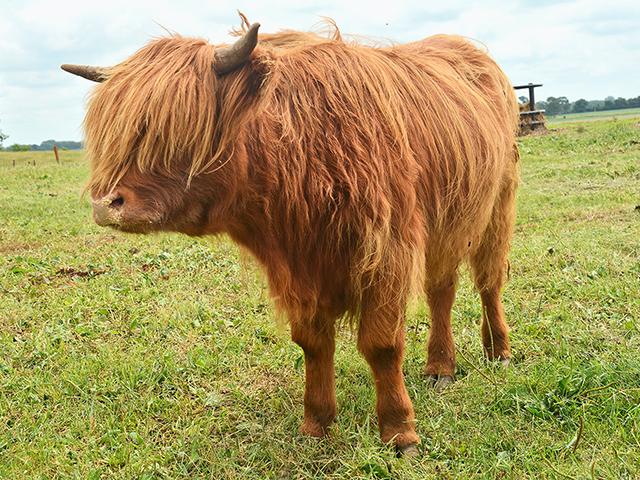Hippie Cows
Go Back in Time
Josh Nelson refers affectionately to his Highland cattle as "long-haired hippie cows." They are head-turners, but there's a lot more to the breed than meets the eye.
On Nelson's central-Iowa operation, Cardinal Creek Farm, these cattle are providing a consumer-direct revenue stream on which the fifth-generation farm family intends to keep building. With Highland beef, Nelson says one of the first things new buyers mention after trying it is how tender and lean it is compared to supermarket beef. Those genetics are one of the advantages of this breed.
"It's all about how the Highland grow," Nelson explains. "Compared to your Angus, Highland cattle are much slower maturing. Their rate of gain is probably half of Angus. You finish them at an older age, around 2 years, when they'll average about 1,100 pounds on the hoof. The meat isn't as marbled as what a lot of people are used to seeing, but it's incredibly lean and tender. Fatty cuts of meat don't necessarily mean tender."
Studies in Canada and the U.K., where naturally aged Highland beef is more common, report it registers high on the tenderness scale. The Scottish Agricultural College notes the breed's heavy coat, which insulates against the climate and reduces development of excess back fat, making Highland beef consistently lower in fat and cholesterol than other breeds. The data shows fat content per 100 grams on a Highland at 4.5 grams; other beef breeds overall average 15.6 grams. Cholesterol content was 40.9 grams on the Highland, 64.3 grams in the other breeds.
Numbers like that, along with the experience of eating Highland beef, have built a strong customer base for the Nelsons. But, like other producers trying to market directly, they ran into backlogs at the locker during the height of the pandemic.
"COVID-19 broke out during what is our traditional marketing time," Nelson says. "The steers were ready to go, the customers were ready, and then everything started slamming shut. We were lucky we got all the cattle harvested except one steer."
THE WAY THINGS HAPPEN
Like most good things, Nelson never saw his Highland business coming. His intention was to raise Hereford, and he was especially interested in the grass-fed niche. But, he met a guy who raised Highland cattle, and when he started learning about the breed and how well it does on forages, his plans changed.
P[L1] D[0x0] M[300x250] OOP[F] ADUNIT[] T[]
"I started out small, with just four head. I still planned to get some Hereford, but the more I was around the Highland, the more I appreciated their character and temperament, and the quality of the beef."
Nelson describes Highland cattle as a "very hearty, pasture-raised breed," adding that they tend to take care of themselves.
"Give them water, shade and grass, and you're good," he says. "They can be like big puppy dogs. We have one heifer, Effie Mae, and she is moody if you don't brush her every day, give her pets and treats. She's a sweetheart. Never did I think I'd be talking about a cow like that. But, she's one you never worry about having your kids around. She might poke you in the rear if you're slow with the treats, but that's about as bad as it gets."
And, what about those horns? Cows can have up to an impressive 48-inch span. Nelson says most people don't know those horns have a purpose beyond protection against predators.
"Their horns act like big radiators, they are a heat exchanger. There's blood flow in horns, and if you grab them on a hot day, they are really hot. Even on a 100°F day here, I haven't seen them struggle. They go in the shade, catch a breeze and lay down."
CROSSING THEM UP
Like many cattle producers, Nelson likes the idea of crossbreeding to see if he can improve performance. He's trying a Gelbvieh-Highland cross, aimed at giving him more beef supplies throughout the year. His choice of the Gelbvieh was intentional.
"In my experience, they have the same temperament as Highlands -- calm and not too flighty, spooky or aggressive. The cross gives me a bigger, more muscled frame, but it's still hearty in the winter. And, the meat is tender and flavorful. It doesn't change the character of the beef, but I think it gives me more flexibility."
Nelson says in addition to direct sales, he hopes to get noticed in the purebred world of Highlands, where good genetics can boost prices and sales opportunities. At pre-COVID auctions, he was seeing average prices for registered Highland brood cows between $1,500 to $3,200. Highland females are generally sold as unbred yearlings, and they are bred around 2 years of age. Prices on show-quality animals, like in any breed, can quickly climb. Nelson says he's seen these animals hit the $7,000 mark easily.
Today's availability of high-quality semen from champion bulls and improved conception rates using artificial insemination (AI) in cattle have opened the door to more genetic diversification for many producers.
"A lot of people are playing with AI on these cattle now," Nelson says. "Even though this is a small cattle world, we are able to capture that genetic diversity through the use of this technology. Plus, this means I don't need a bull."
**
For More Information:
-- The Livestock Conservancy: www.livestockconservancy.org
-- Cardinal Creek Farm: www.facebook.com/cardinalcreekfarmia
-- Follow Vicki on Twitter @myersPF
[PF_0322]
(c) Copyright 2022 DTN, LLC. All rights reserved.




